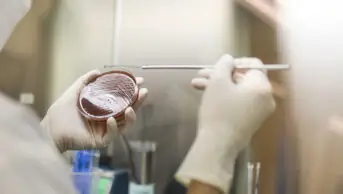
Imagedoc / Alamy Stock Photo
The prescription of antibiotics is continuing to rise in England despite campaigns to curb their use because of concerns of rising antimicrobial resistance and a shortage of new antibiotics in the pipeline, Public Health England (PHE) has warned.
The prescribing of antibiotics by GPs and hospital doctors has risen by 6% between 2010 and 2013 from 25.9 to 27.4 daily defined doses per 1,000 inhabitants per day, according to the first annual report of PHE’s English Surveillance Programme for Antimicrobial Utilisation and Resistance[1]
, which was established as part of the government’s five-year strategy to address antibiotic resistance.
The number of antibiotic prescriptions increased by 32% in community settings by non-GPs such as dentists, while prescriptions for inpatients in hospitals rose by 12%. Prescribing by GPs saw the smallest rise, with the number of prescriptions up by 4%.
At the same time, the number of Escherichia coli bloodstream infections – the most common cause of septicaemia – has risen: between 2010 and 2013, the incidence in England increased by 12% from 47.0 cases to 52.6 cases per 100,000 population.
The report states that while resistance to four groups of antibiotics – ciprofloxacin, third-generation cephalosporins, gentamicin and imipenem/meropenem – remained relatively stable, the increasing incidence of E. coli during this time meant that the “burden of antibiotic resistance, as measured by total numbers of resistant isolates, nonetheless increased”.
Higher rates of resistance were seen in geographical areas with higher rates of antibiotic prescribing. The highest combined general practice and hospital prescribing rates in England was in Merseyside, with levels more than 30% higher than the Thames Valley, which had the lowest.
“Antibiotic resistance is one of the biggest threats of our time and understanding more about who is prescribing and what is being prescribed is the first step to helping us make improvements,” says Anthony Kessel, director of international public health at PHE.
Susan Hopkins, a healthcare epidemiologist at PHE and lead author of the report, says the aim is to reduce levels of prescribing back to those of 2010. “There are already a number of different activities going ahead to support this, including the development of quality measures for prescribing,” she says. “This will enable local clinical commissioning groups (CCGs) to monitor the prescribing of hospitals and surgeries in their area and see how they compare against a benchmark. They will also be responsible for taking action against inappropriate prescribing in their area.”
According to a survey for the PHE report, by 2014 most NHS trusts had reviewed the national guidance on antimicrobial stewardship in secondary care – known as Start Smart Then Focus (SSTF) – but fewer than half had instituted an action plan to improve stewardship. The results also showed that, while more than 90% of NHS trusts had an antimicrobial stewardship committee, representation from hospital physicians, surgeons, nurses and pharmacists was low. Two thirds of trusts provided training in stewardship and antibiotics but only a minority performed prescribing competency assessments, the findings show.
“In order to embed antimicrobial stewardship recommendations within hospitals, engagement with a broad range of professional groups, including doctors (both senior and junior), surgeons, nurses and pharmacists, is essential,” the report says.
Kieran Hand, the Royal Pharmaceutical Society spokesperson on antibiotics and a consultant pharmacist in anti-infectives at University Hospital Southampton NHS Foundation Trust, says there needs to be a focus on unnecessary use of antibiotics.
“Specialist pharmacists in hospitals and pharmacist prescribing advisers in primary care have been successful in promoting a switch in choice of antibiotics away from cephalosporins and fluoroquinolones, and this has coincided with a significant reduction in Clostridium difficile infections and a plateau in resistance to these drugs in common pathogens,” he says.
“We now need to move on to the much more challenging task of reducing inappropriate initiation of antibiotics in the absence of evidence of infection and to reducing course length. In particular, a focus on review of antibiotic prescriptions in hospitals at 48-72 hours will be critical to reducing unnecessarily prolonged courses.”
The PHE report highlighted the importance of cross-sector antimicrobial stewardship in tackling inappropriate antibiotic use, but the 2014 survey found that only 37% of trusts had a working relationship with a primary care pharmacy in their area.
Hand emphasised that there was great scope for reducing unnecessary prescribing in primary care, where more than 60% of patients with upper respiratory tract infection still receive antibiotics. He called for prescribing adviser pharmacists in clinical commissioning groups (CCGs) to be trained to deliver educational messages to GP practices on how to safely reduce prescribing and to support GPs with benchmarking of prescribing data.


